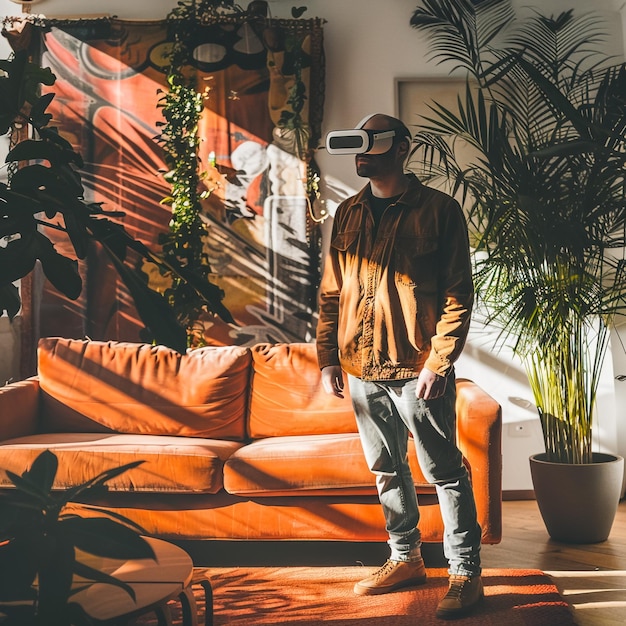The Future of Home Entertainment: Immersive Experiences & Beyond

The future of home entertainment will revolutionize how we experience media through immersive technologies like VR and AR, personalized content delivery, and interactive experiences, creating more engaging and tailored entertainment environments.
The way we enjoy entertainment within our homes is on the cusp of a massive transformation. The Future of Home Entertainment: Immersive Experiences and Beyond promises to redefine how we consume media, interact with content, and design our living spaces to accommodate these changes.
The Evolution of Home Entertainment Systems
Home **entertainment** has come a long way from the simple radio and television. Technological advancements have steadily transformed how we experience media within our homes, paving the way for a truly immersive future.
From Analog to Digital: A Transformative Shift
The transition from analog to digital formats revolutionized home entertainment. Digital media offered superior sound and picture quality, greater storage capacity, and easier access to content.
The Rise of Streaming Services and On-Demand Content
Streaming services like Netflix, Hulu, and Spotify have fundamentally altered how we consume media. On-demand content empowers viewers and listeners to access their favorite movies, shows, and music whenever and wherever they want.

Here are some key milestones in the evolution of home entertainment:
- Invention of Television: Marked the beginning of visual home entertainment.
- Development of VCRs and DVD Players: Allowed users to control their viewing experience.
- Introduction of High-Definition (HD) Technology: Enhanced picture and sound quality.
- Emergence of Smart TVs: Integrated internet connectivity for streaming and interactive features.
The continuous evolution of technology will only enhance the way we experience content. With higher resolutions and refresh rates coming, visual fidelity will only go up, as well as immersive audio.
Immersive Technologies: VR and AR in the Living Room
Virtual Reality (VR) and Augmented Reality (AR) are poised to revolutionize **home entertainment**. These technologies offer unprecedented immersion, transforming passive viewing into interactive experiences.
Virtual Reality (VR): Stepping into Another World
VR transports users to completely simulated environments. By wearing a VR headset, viewers can immerse themselves in virtual worlds, participate in interactive narratives, and experience entertainment in entirely new ways.
Augmented Reality (AR): Blending Digital and Physical Realities
AR overlays digital information onto the real world. Through smartphones, tablets, or AR glasses, users can view virtual objects and information superimposed onto their physical surroundings, enhancing their perception and interaction with the environment.

Here are some ways VR and AR can enhance the future of home entertainment:
- Interactive Gaming: VR and AR can create highly immersive, interactive gaming experiences.
- Virtual Tourism: VR can transport users to exotic locations and historical sites.
- Enhanced Movie Viewing: VR can place viewers in the center of the action, providing a more immersive cinematic experience.
- Educational Experiences: AR can overlay educational information onto real-world objects, facilitating learning and exploration.
The development of more comfortable and intuitive VR/AR headsets, coupled with improved content creation tools, will further accelerate the adoption of these technologies in homes worldwide.
Personalized Entertainment Experiences: AI and Customization
Artificial Intelligence (AI) plays a crucial role in shaping the future of home **entertainment**. AI algorithms analyze user data to provide personalized recommendations and customize entertainment experiences.
AI-Powered Content Recommendations
AI algorithms analyze viewing history, preferences, and ratings to suggest content that aligns with individual tastes. This personalized approach helps users discover new movies, shows, and music they might enjoy.
Customizable User Interfaces and Experiences
AI can also personalize user interfaces and experiences. Smart TVs and streaming devices can adapt their layouts and features to suit individual preferences, making it easier for users to navigate and access their favorite content.
AI-driven personalization offers numerous advantages:
- Enhanced Content Discovery: Users can easily find content that aligns with their interests.
- Improved User Experience: Personalized interfaces and features make navigating entertainment systems more intuitive and enjoyable.
- Increased Engagement: Tailored experiences keep users engaged and entertained.
The integration of AI into home entertainment systems will continue to evolve, with algorithms becoming more sophisticated and capable of delivering highly personalized and relevant experiences.
The Smart Home Ecosystem: Integration and Interoperability
The future of home **entertainment** is deeply intertwined with the smart home ecosystem. Seamless integration and interoperability between devices and platforms will be essential for creating a unified and connected entertainment environment.
Voice Control and Smart Assistants
Voice control via smart assistants like Amazon Alexa and Google Assistant is becoming increasingly prevalent in home entertainment. Users can use voice commands to control their TVs, streaming devices, and other entertainment systems.
Interconnected Devices and Platforms
Seamless integration between devices and platforms enables users to easily access and control their entertainment from any room in the house. For instance, users can start watching a movie on their smart TV and then continue watching it on their tablet while moving to another room. This is facilitated through the smart home platform.
The integration of home entertainment into the smart home ecosystem offers several benefits:
- Simplified Control: Users can control their entire entertainment setup with voice commands or a single app.
- Enhanced Convenience: Seamless integration between devices and platforms makes it easy to access and enjoy content from anywhere in the home.
- Automated Experiences: Smart home systems can automate entertainment experiences, such as dimming the lights and turning on the TV when a movie starts.
The development of open standards and protocols will further promote interoperability, allowing devices and platforms from different manufacturers to work together seamlessly.
The Role of 5G and Enhanced Connectivity
5G technology is poised to play a significant role in the future of home **entertainment**. Its high speeds, low latency, and increased bandwidth will enable new and enhanced entertainment experiences.
High-Speed Streaming and Reduced Latency
5G will enable seamless streaming of high-resolution content, such as 4K and 8K videos, without buffering or interruptions. Reduced latency will also improve interactive experiences like online gaming and VR applications.
Enhanced Mobile Entertainment
5G will transform mobile entertainment by enabling users to stream high-quality content and participate in interactive experiences on the go.
The benefits of 5G for home entertainment are substantial:
- Improved Streaming Quality: 5G enables seamless streaming of high-resolution content without buffering.
- Enhanced Interactive Experiences: Reduced latency improves online gaming and VR applications.
- Greater Mobility: 5G enables users to enjoy high-quality entertainment on the go.
The widespread deployment of 5G networks will unlock new possibilities for innovation in the home entertainment industry, enabling more immersive, interactive, and personalized experiences.
The Future of Home Entertainment: A Sustainable Approach
As we look to the future of home **entertainment**, sustainability will be an important consideration. Consumers are increasingly aware of the environmental impact of their technology and are seeking more eco-friendly options.
Energy-Efficient Devices and Practices
Manufacturers are developing more energy-efficient TVs, streaming devices, and other entertainment systems. These devices consume less power and reduce carbon emissions.
Sustainable Content and Packaging
Streaming services and content providers are also adopting sustainable practices, such as reducing their carbon footprint and using eco-friendly packaging materials. This means less plastic packaging for consumers to discard.
Here are some ways to promote sustainability in home entertainment:
- Choose Energy-Efficient Devices: Look for devices with Energy Star certification.
- Use Streaming Services Responsibly: Avoid unnecessary streaming and download content when possible.
- Recycle Old Electronics: Dispose of old TVs, streaming devices, and other electronics responsibly.
By adopting sustainable practices, consumers can reduce their environmental impact and contribute to a more eco-friendly future for home entertainment.
Key HighlightsEntertainment Tech InnovationsEco-Friendly EntertainmentConclusion
Conclusion
The future of home entertainment is incredibly exciting, with innovations like immersive technologies, AI personalization, and smart home integration set to revolutionize how we experience media. As technology evolves, we can expect even more engaging, personalized, and sustainable entertainment experiences within our homes.
Read more content





